Getting Your Kids into the Kitchen
Want to raise healthy eaters? Experts agree that one of the single most important things you can do for your health is cook at home, and if you want healthy eaters, include your children while you do it. Most children enjoy helping in the kitchen, which poses a great opportunity to get them involved and let them learn the basics.
Benefits of including your child in the kitchen
- Cooking together is an easy way to talk about health and the benefits of heathy ingredients.
- Children who cook are more likely to taste new foods of different colors and textures.
- Teaching your child to make a new recipe can cultivate a welcoming and open-minded approach to food.
- Having a hands-on experience in the kitchen seems to positively influence children’s food preferences and behaviors.
- Getting children involved in the kitchen either at home or in a cooking class may increase the likelihood that they will choose healthy foods.
It may be hard to know when a child is ready to start helping with certain tasks. Here are a few recommendations of age appropriate tasks in the kitchen. And as always use your judgement on what tasks your child is ready for.
Kitchen tasks by age group
Under 3:
At this age your child may be very interested in what’s going on in the kitchen but not quite ready to help with many tasks. The most important thing here is to make sure that the kitchen is safe of hot foods, liquids, surfaces, and trip hazards. Once you’ve cleared the way you can start with easy tasks such as:
- Washing fruits and vegetables.
- Breaking vegetables into pieces.
3-4-year-olds:
As your child masters the skills above and can follow instructions, they can start a wider range of tasks to help in the kitchen. Skills can vary greatly at this age so your judgement will be important. Include activities such as:
- Mixing ingredients.
- Kneading or shaping ingredients.
- Counting scoops.
- Sprinkling – flour, decorations, spices.
- Peeling oranges.
- Mashing ingredients.
- Weighing ingredients.
5-6 year olds:
At this age, most parents can introduce their child to more complex tasks, including the introduction of tools. Again, it’s very important to use your judgment and if you do let you child use tools, keep a close eye and consider buying a tool designed for a child’s use. Try activities such as:
- Measuring ingredients.
- Reading recipes.
- Cutting herbs with safe scissors.
- Grating ingredients (be careful and use a child safe tool).
- Greasing pans and dishes.
- Beating and folding into a recipe.
- Setting the table.
8-11 year olds:
At this age, your child is most likely to take on some independence. Start involving your child in some of the bigger activities such as:
- Planning a family meal.
- Following a simple recipe.
- Using a peeler.
- Opening cans.
As your child helps you more and more in the kitchen, they may be able to master more skills with your help. As they gain more experience and become older, give them an opportunity to use their imagination and creativity with their dishes. Your child will learn many life lessons though cooking, including the most important ,which is a healthy relationship with the food they eat.
References:
Academy of Nutrition and Dietetics: The Joy of Cooking with Kids During the Holidays. www.eatright.org/resource/homefoodsafety/safety-tips/holidays/the-joy-of-cooking-with-kids-during-the-holidays
Hersch D, Perdue L, Ambroz T, Boucher JL (2014). “The impact of cooking classes on food-related preferences, attitudes, and behaviors of school-aged children: a systematic review of the evidence, 2003-2014.” Prev Chronic Dis. 2014 Nov 6; 11():E193.
National Institutes of Health: Getting Kids in the Kitchen www.nhlbi.nih.gov/health/educational/wecan/downloads/cookwithchildren.pdf
U.S. National Library of Medicine: https://medlineplus.gov/childnutrition.html




